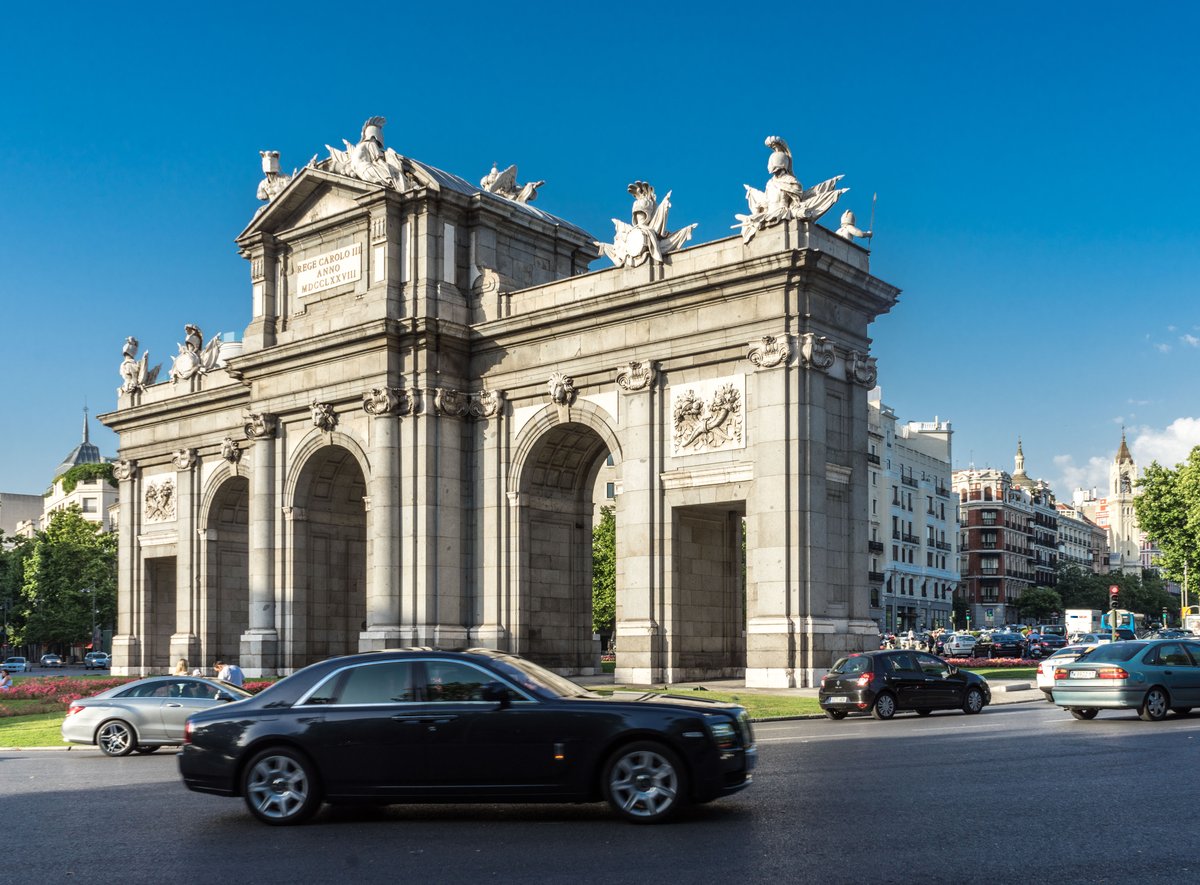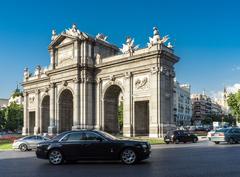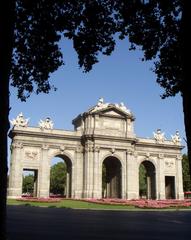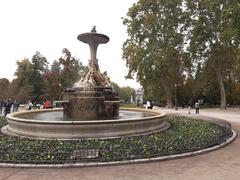
Puerta de Alcalá: Visiting Hours, Tickets, and Historical Sites in Madrid
Date: 14/06/2025
Introduction
Rising majestically at Plaza de la Independencia, the Puerta de Alcalá is a neoclassical triumphal arch and one of Madrid’s most iconic landmarks. Commissioned by King Carlos III and designed by Italian architect Francesco Sabatini, this 18th-century monument served as a ceremonial gateway to the city and today is celebrated for both its architectural grandeur and enduring cultural significance. As a focal point of Madrid’s “Landscape of Light” UNESCO World Heritage Site, the Puerta de Alcalá remains freely accessible to all, drawing history enthusiasts, art admirers, and travelers alike. This guide provides a comprehensive overview, including historical context, architectural features, practical visitor information, travel tips, and recommendations for exploring nearby attractions (inspain.org; Spain.info; EsMadrid).
Historical Background
Origins and Construction
The Puerta de Alcalá was built between 1769 and 1778, replacing a less impressive Baroque gate. King Carlos III, intent on modernizing Madrid, commissioned Francesco Sabatini to design a stately entrance for visitors arriving from Alcalá de Henares. Standing 19.5 meters tall and constructed from granite and white stone, the monument quickly became a symbol of the city’s aspirations and transformation (inspain.org).
Architectural Style and Features
A hallmark of Neoclassical architecture, the Puerta de Alcalá features five passageways—three grand semicircular arches flanked by two rectangular openings. Its symmetrical form, harmonious proportions, and restrained ornamentation reflect the Enlightenment ideals of the late 18th century. The central arch is crowned by a curved and triangular gable, while the upper sections are enriched by sculptural details, including military trophies and allegorical figures (inspain.org).
Artistic Contributions
Sculptors Francisco Gutiérrez and Roberto Michel collaborated on the monument’s detailed ornamentation. Notably, lion heads crown each archway, symbolizing strength, while statues representing the cardinal virtues—Prudence, Justice, Temperance, and Fortitude—stand atop the central arches, embodying the era’s civic values (Madridista Forever; History Hit). The inscription “Carlos III. Año 1778” commemorates its royal patron and completion date.
Symbolic and Urban Significance
Strategically positioned at the city’s eastern boundary, the Puerta de Alcalá served as the main entrance for visitors arriving from Alcalá de Henares. Its design drew inspiration from Roman triumphal arches, making it the first of its kind in post-Roman Europe. Today, as a key component of the “Landscape of Light,” the gate forms a visual and cultural axis with Retiro Park, the Prado Museum, and other nearby landmarks (EsMadrid).
Visiting the Puerta de Alcalá: Essential Information
Location and Accessibility
- Address: Plaza de la Independencia, s/n, 28001 Madrid, Spain
- Metro: Retiro (Line 2) is the nearest station; Banco de España (Line 2) and Serrano (Line 4) are also within walking distance.
- Bus: Multiple city buses stop at Plaza de la Independencia (lines 1, 2, 9, 15, 20, 28, 51, 52, 74, 146, 202)
- Bicycle: BiciMAD docking stations are nearby for bike-sharing
- Walking: Central location makes it accessible on foot from major neighborhoods (The Tourist Checklist; Viajaconapina)
The monument is surrounded by wide, level sidewalks with pedestrian crossings, ensuring accessibility for visitors with reduced mobility.
Visiting Hours and Tickets
- Hours: As an outdoor monument, the Puerta de Alcalá is accessible 24 hours a day, every day of the year (Viajaconapina)
- Tickets: No admission fee or ticket is required. The site is open and free to the public.
Guided Tours
Many walking tours of Madrid’s historic center feature the Puerta de Alcalá. Audio guides and app-based tours are available for those seeking in-depth historical and architectural insights (EsMadrid).
Amenities
- Restrooms: Available in nearby Retiro Park and local cafés
- Seating: Benches in Retiro Park and around the plaza
- Food & Drink: Numerous cafés and restaurants are located around Plaza de la Independencia and along Calle de Alcalá (The Tourist Checklist)
Travel Tips and Visitor Recommendations
Best Times to Visit
- Early Morning: Ideal for peaceful views, soft lighting, and minimal crowds.
- Evening: The monument is beautifully illuminated at night, offering striking photo opportunities and a romantic atmosphere (Madrid-Tourist.com).
- Weekdays: Generally less crowded than weekends.
Photography Tips
- Angles: Walk around the plaza for different perspectives.
- Lighting: Early morning and evening provide the best natural light; nighttime illumination creates dramatic effects.
- Crowds: Visit during off-peak hours for clear shots (Flip Flops Included).
Safety
- Traffic: The monument sits in a busy roundabout; use marked pedestrian crossings and remain alert to traffic (Viajaconapina).
- Weather: Dress appropriately for Madrid’s climate and bring sun protection during summer.
- Accessibility: The entire area is pedestrian-friendly and accommodates wheelchairs and strollers.
Cultural and Social Significance
The Puerta de Alcalá is a living emblem of Madrid’s identity. Its image appears in art, literature, and music—most notably the popular song “La Puerta de Alcalá” by Ana Belén and Víctor Manuel, beloved among locals (Viajaconapina). The monument serves as a gathering point for festivals, celebrations, charity events, and public demonstrations, anchoring urban life in the upscale Salamanca district.
Nearby Attractions
- El Retiro Park: Expansive gardens, walking trails, and historical monuments adjacent to the gate (The Tourist Checklist).
- Museo del Prado: World-renowned art museum within a 10-minute walk.
- Cibeles Palace and Fountain: Iconic city hall and viewpoint nearby.
- National Archaeological Museum: Insight into Spain’s ancient history.
Frequently Asked Questions (FAQ)
Q: What are the Puerta de Alcalá visiting hours?
A: The monument is outdoors and accessible 24/7, year-round.
Q: Is there an entrance fee or tickets required?
A: No, visiting the Puerta de Alcalá is completely free.
Q: Are guided tours available?
A: Yes, many Madrid city tours include the monument, and audio guides are available.
Q: Is the area accessible for people with disabilities?
A: Yes, the surrounding plaza is wheelchair-accessible with level sidewalks and crossings.
Q: What is the best time to visit for photography?
A: Early morning, late afternoon, and nighttime when the monument is illuminated.
Visual Gallery
- Puerta de Alcalá at sunrise, Plaza de la Independencia, Madrid
- Detail of neoclassical sculptures and arches
- Nighttime illumination of Puerta de Alcalá
Related Articles
Conclusion
The Puerta de Alcalá is much more than an architectural marvel—it is a vibrant symbol of Madrid’s endurance, civic pride, and cosmopolitan spirit. Its accessible location, rich history, and proximity to major attractions make it an essential destination for every visitor. Plan your trip during off-peak hours for the best experience, and don’t forget to explore the surrounding cultural treasures. For guided tours, live updates, and exclusive tips, download the Audiala app, and follow us on social media for the latest news on Madrid’s cultural heritage.
Summary and Visitor Recommendations
From its origins as a regal city gate to its current status as a freely accessible landmark, the Puerta de Alcalá remains a timeless emblem of Madrid’s historical depth and artistic achievement. Its neoclassical elegance, strategic location in Plaza de la Independencia, and integration with Madrid’s urban and cultural life ensure its continual relevance. Visitors benefit from its accessibility, the variety of nearby attractions, and opportunities for guided tours and local events. For a seamless visit, leverage digital tools like the Audiala app and stay connected with official tourism updates (inspain.org; EsMadrid; Madridista Forever).
Sources and Further Reading
- Puerta de Alcalá: A Complete Guide to Madrid’s Iconic Historical Monument, Visiting Hours, Tickets, and Nearby Attractions (inspain.org)
- Puerta de Alcalá: Visiting Hours, Tickets, and Architectural Highlights (Madridista Forever)
- Puerta de Alcalá Visiting Hours, Tickets & Cultural Significance (EsMadrid)
- Puerta de Alcalá Visiting Hours, Tickets, and Practical Tips (The Tourist Checklist)
- Spain.info, Puerta de Alcalá Madrid




































































































